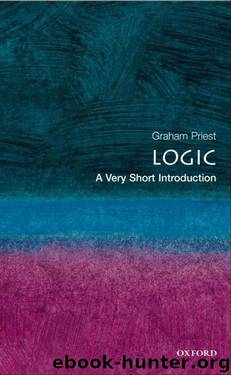Logic: A Very Short Introduction (Very Short Introductions) by Priest Graham

Author:Priest, Graham [Priest, Graham]
Language: eng
Format: epub
Publisher: Oxford University Press
Published: 2000-10-11T21:00:00+00:00
The first inference is valid, since if r is true in some situation, s0, then in any situation to the right of s0, say s1, Pr is true (since s0 is to its left). But then, FPr is true in s0, since s1 is to its right. We can depict things like this:
The second inference is valid, since if FHr is true in s0, then in some situation to the right of s0, say s2, Hr is true. But then in all situations to the left of s2, and so in particular s0, r is true:
Moreover, certain combinations of tenses are impossible, as one would expect. Thus, if h is a sentence that is true in just one situation, say s0, then Ph & Fh is false in every s. Both conjuncts are false in s0; the first conjunct is false to the left of s0; the second conjunct is false to the right. Similarly, e.g., PPh & FFh is false in every s. I leave you to check the details.
Now, how does all this bear on McTaggart’s argument? The upshot of McTaggart’s argument, recall, was that, given that h has every possible tense, it is never possible to avoid contradiction. Resolving contradictions in one level of complexity for compound tenses only creates them in another. The account of the tense operators that I have just given, shows this to be false. Suppose that h is true in just s0. Then any statement with a compound tense concerning h is true somewhere. For example, consider FPPFh. This is true in s-2, as the following diagram shows:
Download
This site does not store any files on its server. We only index and link to content provided by other sites. Please contact the content providers to delete copyright contents if any and email us, we'll remove relevant links or contents immediately.
| Algebra | Calculus |
| Combinatorics | Discrete Mathematics |
| Finite Mathematics | Fractals |
| Functional Analysis | Group Theory |
| Logic | Number Theory |
| Set Theory |
Modelling of Convective Heat and Mass Transfer in Rotating Flows by Igor V. Shevchuk(6393)
Weapons of Math Destruction by Cathy O'Neil(6156)
Factfulness: Ten Reasons We're Wrong About the World – and Why Things Are Better Than You Think by Hans Rosling(4696)
Descartes' Error by Antonio Damasio(3233)
A Mind For Numbers: How to Excel at Math and Science (Even If You Flunked Algebra) by Barbara Oakley(3226)
Factfulness_Ten Reasons We're Wrong About the World_and Why Things Are Better Than You Think by Hans Rosling(3202)
TCP IP by Todd Lammle(3138)
Fooled by Randomness: The Hidden Role of Chance in Life and in the Markets by Nassim Nicholas Taleb(3051)
Applied Predictive Modeling by Max Kuhn & Kjell Johnson(3021)
The Tyranny of Metrics by Jerry Z. Muller(3009)
The Book of Numbers by Peter Bentley(2914)
The Great Unknown by Marcus du Sautoy(2651)
Once Upon an Algorithm by Martin Erwig(2603)
Easy Algebra Step-by-Step by Sandra Luna McCune(2588)
Lady Luck by Kristen Ashley(2537)
Practical Guide To Principal Component Methods in R (Multivariate Analysis Book 2) by Alboukadel Kassambara(2498)
Police Exams Prep 2018-2019 by Kaplan Test Prep(2490)
All Things Reconsidered by Bill Thompson III(2359)
Linear Time-Invariant Systems, Behaviors and Modules by Ulrich Oberst & Martin Scheicher & Ingrid Scheicher(2335)
